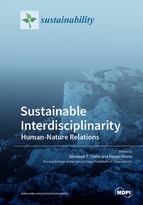Sustainable Interdisciplinarity: Human-Nature Relations
A special issue of Sustainability (ISSN 2071-1050).
Deadline for manuscript submissions: closed (31 October 2019) | Viewed by 75411
Special Issue Editors
2. University of Gdansk, 80-309 Gdańsk, Poland
Interests: human geography; sustainability; consumption; globalisation and resources; sustainability indices and trends; interdisciplinary societal studies
Special Issues, Collections and Topics in MDPI journals
Interests: smart cities; ecosystem services; sustainable landscape design; urban sustainability; green infrastructure
Special Issues, Collections and Topics in MDPI journals
Special Issue Information
Dear Colleagues,
Sustainable interdisciplinarity focuses on human–nature relations and a multitude of contemporary overlapping research conducted within society. A variety of disciplines have played a large part in better understanding sustainability since its high profile emergence approximately a quarter-century ago. At present, the forefront of sustainability research is an array of methods, techniques, and growing knowledge-base that takes into account past, present, and future pathways. Special multi-discipline concentrations include: Sustainability within social change, political transformations, international comparative studies on the environment and understanding how well key theories and dynamics perform in practice. Specializations in complex sustainability issues address international governance arrangements, rules and organizations—both public and private. Pressing issues are those related to biodiversity, water quality and quantity, quality of ecosystems and natural resource suppliers. In terms of multinational corporations, the private sector plays a crucial role in shaping sustainability in the current economic paradigm. Innovative environmental partnerships, specifically focusing on the role of societal and ethical responsibility of business and the market, at large, are key within this paradigmatic focus. Research into sustainable societies needs to be sound, ethical and creative by forming sustainably higher standards of living that support current and future generations.
This Special Issue aims to shed light on a wide array of research activities within the scope of four themes: sustainability, human geography, environment and interdisciplinary societal studies. These themes are further broken down into supporting tracks and exemplify sustainable interdisciplinarity. Researchers are invited to contribute original research articles that look at and understand novel knowledge-base central to these themes or their supporting tracks. Articles will exemplify novelty, technical depth, elegance, practical or theoretic impact and presentation.
▪ Theme 1: Sustainability
Supporting tracks: Governance, globalization, consumption, sustainability indices, ecosystem services, urban sustainability, green infrastructure
▪ Theme 2: Human Geography
Supporting tracks: Developing world, Africa, Asia, Latin America, global health and medical geography, remote sensing, population migration, transportation, food and agriculture, geographic information systems
▪ Theme 3: Environment
Supporting tracks: Nature and culture, energy and climate, resource management, conservation, environmental ethics, environmental management systems
▪ Theme 4: Interdisciplinary Societal Studies
Supporting tracks: Society studies, rights, socioeconomics, politics of food, gender, poverty and aid, political ecology, geopolitics
Prof. Dr. Giuseppe T. Cirella
Prof. Dr. Alessio Russo
Guest Editors
Manuscript Submission Information
Manuscripts should be submitted online at www.mdpi.com by registering and logging in to this website. Once you are registered, click here to go to the submission form. Manuscripts can be submitted until the deadline. All submissions that pass pre-check are peer-reviewed. Accepted papers will be published continuously in the journal (as soon as accepted) and will be listed together on the special issue website. Research articles, review articles as well as short communications are invited. For planned papers, a title and short abstract (about 100 words) can be sent to the Editorial Office for announcement on this website.
Submitted manuscripts should not have been published previously, nor be under consideration for publication elsewhere (except conference proceedings papers). All manuscripts are thoroughly refereed through a single-blind peer-review process. A guide for authors and other relevant information for submission of manuscripts is available on the Instructions for Authors page. Sustainability is an international peer-reviewed open access semimonthly journal published by MDPI.
Please visit the Instructions for Authors page before submitting a manuscript. The Article Processing Charge (APC) for publication in this open access journal is 2400 CHF (Swiss Francs). Submitted papers should be well formatted and use good English. Authors may use MDPI's English editing service prior to publication or during author revisions.
Keywords
- Sustainability
- Human Geography
- Environment
- Interdisciplinary Societal Studies







